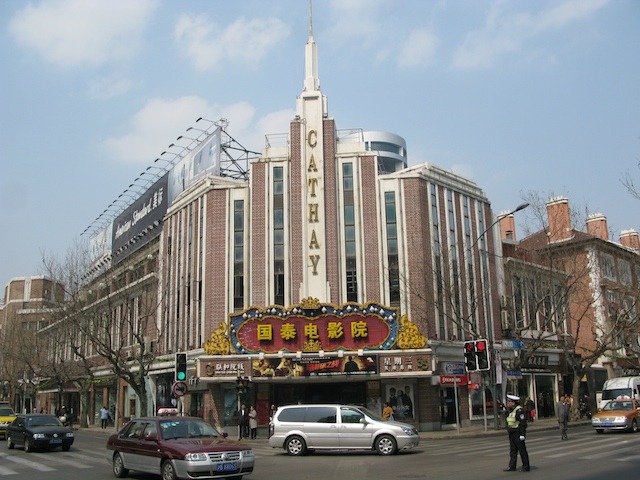Yesterday I took my NYU Modern Chinese History students on a tour of the Heart of the Old French Concession. Here are some of the highlights:

We began at the Okura Garden Hotel, which was once the grounds for the Cercle Sportif Francais otherwise known as the French Club. Built in the mid-1920s, this club was the centerpiece of French social life in the Concession. It featured a swimming pool, billiard tables, library, and a fantastic ballroom where wild parties were held. In addition to French nationals the club invited other nationalities to join, and it was open to female as well as male membership (a rarity in the days of Gentlemen's Clubs). We took a quick look at the ballroom but an event was going on inside so we were unable to step inside it and bask in its glory.

After the Garden Hotel we strolled down Maoming Road and across Huaihai Road, where we stopped to take in the Deco Cathay Cinema. Built in the early 1930s this was one of Shanghai's 30 or so cinemas featuring Hollywood films as well as their counterparts made in Shanghai.

Further down Maoming South Road we stopped at the corner of Nanchang Road to visit the Huaihai Fang, once known as the Joffre Terrace. I pointed out the signs beautifully hand-written on the blackboards at the entrance gate. This one says "expand cooperation in communication, promote the togetherness of the nationalities" or something to that effect. To the upper right are two lovely minority lasses, symbolizing the harmony between the minority nationalities and the Han majority. This may have been put up to remind people to be nice to the Uighurs and other minorities who get unruly now and then...

This sign offers instructions for how to take advantage of free prenatal exams. While admiring this sign, who should walk by but the ladies who had chalked it onto the board. They are part of the local neighborhood committee. We expressed our admiration for their work and they responded by giving us a free copy of a wonderful book that describes many of the famous people who lived in this neighborhood and others in the area.

This is one of them. Xu Beihong was a famous artist from the early twentieth century and one of China's pioneer modernists. He studied in Paris in the 1920s and returned to Shanghai to teach. He's probably most famous for his flowing ink paintings of wild horses.

Walking further into the neighborhood one can see the fishbone pattern of alleyways that make up this typical longtang. Below one sees the identical rowhouses of 3 stories that make up this community. This was the standard mode of housing for Shanghai throughout the twentieth century. It was in these neighborhoods that most Shanghai residents lived, until the emergence of a new real estate market in the 1990s which brought huge apartment complexes into the city. Most of these old longtang neighborhoods have been destroyed but dozens remain. This is one of the better preserved ones.

Walking down this alleyway one comes to two more former residences of famous people from the pre-Liberation era. The first is Ba Jin, a modern writer associated with the May Fourth Era of the 1920s. He lived here in 1937. I have a custom of always taking a group photo in front of his plaque. The second is Xu Guangping, wife of the uber-famous writer Lu Xun. It was in this alleyway that she spent the next twelve years of her life after her husband's death in 1936, compiling and editing his Collected Works. I always enjoy telling the bittersweet love story of the teacher and his student to my groups.

After our tour of Joffre Terrace, we ambled down Nanchang Road towards the Old French Park. Known as Route Vallon in the Concession era, this street attracted many of China's leading revolutionaries, including CCP founder Chen Duxiu who lived there in the early 1920s. It was in another alleyway that he edited the super-influential journal New Youth (Xin Qingnian or La Jeunesse), which featured articles and stories by many leading writers and intellectuals of the May Fourth Era. Normally I would take students there but this time we veered down Sinan Road and ended up making a brief tour of the grounds of the new Sinan Mansions area, another Xintiandi-like neighborhood featuring bars, restaurants, and cafes. We didn't stay long though, since we had to pay a visit to the Father of Modern China.

Our last stop as always was the former residence of Sun Yat-sen, founder of the Guomindang and leader of China's Nationalist movement. He lived in this mansion on the corner of Xiangshan Road and Sinan Road in the early 1920s, where he negotiated a fateful agreement with the fledgling CCP, offering them a place in his much larger revolutionary party in exchange for Soviet aid and advisors so that they could build a Revolutionary Army and take the country over and establish a unified China under Nationalist control. Sun died in 1925 so he didn't get to see this happen, but his erstwhile successor, Chiang Kai-shek, carried on the task of unification. The rest is history. While inside the museum I asked the students to examine how the museum is structured and how it presents and narrates the history of the period and the life of Sun Yat-sen. We are using Kirk Denton's wonderful article on museums in China as a template to investigate how museums portray history and what sort of evidence they marshal to construct their narratives and tell their tales.
